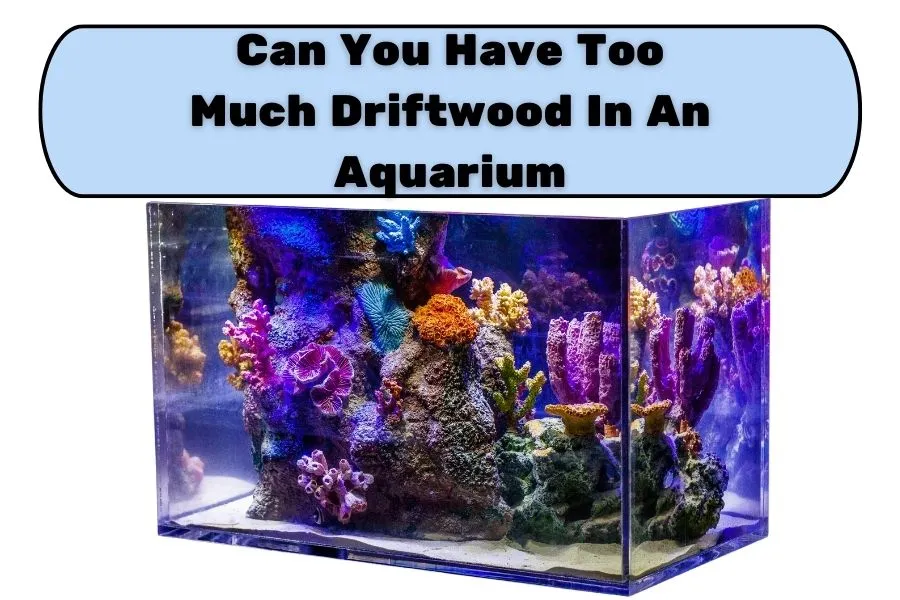It’s common to add driftwood to an aquarium because it looks great, it provides a surface area for algae to grow and a place for animals to hide. Adding driftwood can cause a few issues. Today, I will explain if it’s possible to have too much driftwood in an aquarium.
In general, it is possible to have too much driftwood in an aquarium. Too much driftwood has a minor effect on water pH. But, each type of fish or animal has certain space requirements. Too much driftwood will reduce the volume in a tank, and the animals will be too crowded.
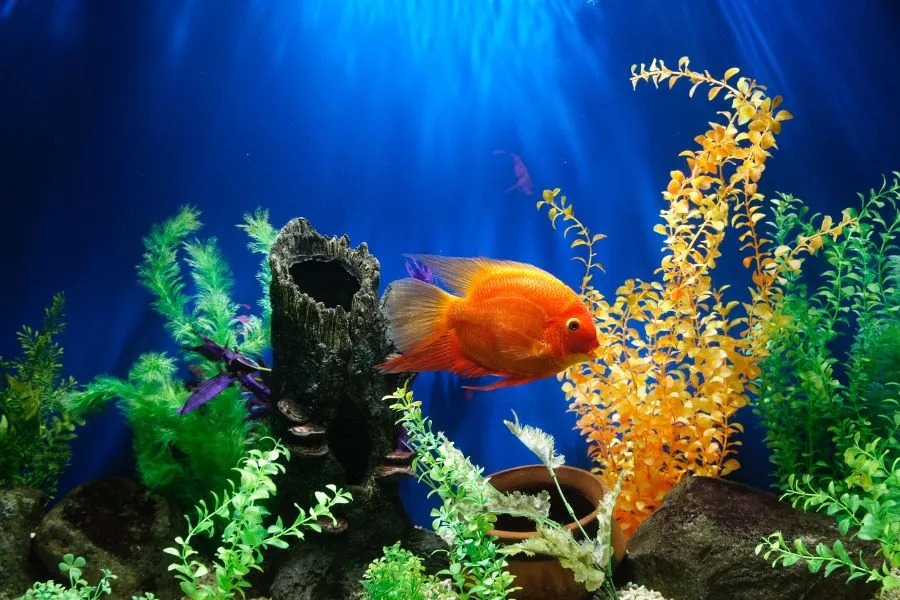
Below, I will cover how driftwood affects water quality, how to stop driftwood from affecting water quality, how much driftwood changes the pH in an aquarium, and if it’s OK to use any type of wood/driftwood in an aquarium.
Does Driftwood Affect Water Quality
Fish and animals in an aquarium are sensitive to changes in water quality. If the temperature is too hot or cold, or the pH is too high or low, it can cause issues for fish and animals in a tank. So, here’s a rundown of whether driftwood affects water quality in any way.
Overall, driftwood does affect water quality. Driftwood produces beneficial nutrients and a place for beneficial algae to grow. But driftwood should be prepared to remove tannins. If this is not done, the water will turn a dark color, and it can affect the pH of the water.
This applies to driftwood you buy in a store and driftwood you source from other locations such as at thrift stores, from the sides of a river, or from the beach. Some species of trees are also not suitable to be used in an aquarium. Some species rot too quickly or contain toxins in the wood.
These toxins will come out into the water over time and can harm fish and animals in the water. At the end of this article, I provide a list of woods that are safe to use and what woods should not be used in an aquarium.

As you may know, tannins are a type of chemical compound that organic plant matter releases. A piece of driftwood will release these slowly over time as it breaks down.
Tannins are mildly acidic. Therefore, they can lower the pH of water slightly. As the water runs through the filter of an aquarium, it will remove the tannins and discoloration over time.
Therefore, if you put a lot of unprepared driftwood into an aquarium, it can reduce the pH below what is comfortable for your fish or animals. Over time, the pH will equilibrate and return to normal levels. But it’s best to avoid this happening.
A piece of driftwood you buy or find will have an accumulation of tannins on the surface. Preparing the driftwood before putting it into an aquarium will remove virtually all of these tannins.
The tannins that will come out of a piece of driftwood after that will be released at a slow enough pace that they won’t affect the water quality. Near the end of this article is a video shows how to remove tannins from driftwood using the boiling method.
Driftwood taking up too much space in an aquarium
All types of animals that you can keep in an aquarium have specific space requirements. This includes fish, turtles, axolotls, sea horses, and crabs. If there is not enough space, then the animals in an aquarium can begin fighting more than normal. And often can kill and eat each other. When they otherwise wouldn’t.
For example, some types of fish are very territorial and will aggressively attack other fish that get too close. But, if there is not enough space for them, they will have no choice but to attack most of the animals in an aquarium. And therefore, they will be stressed and unhappy.
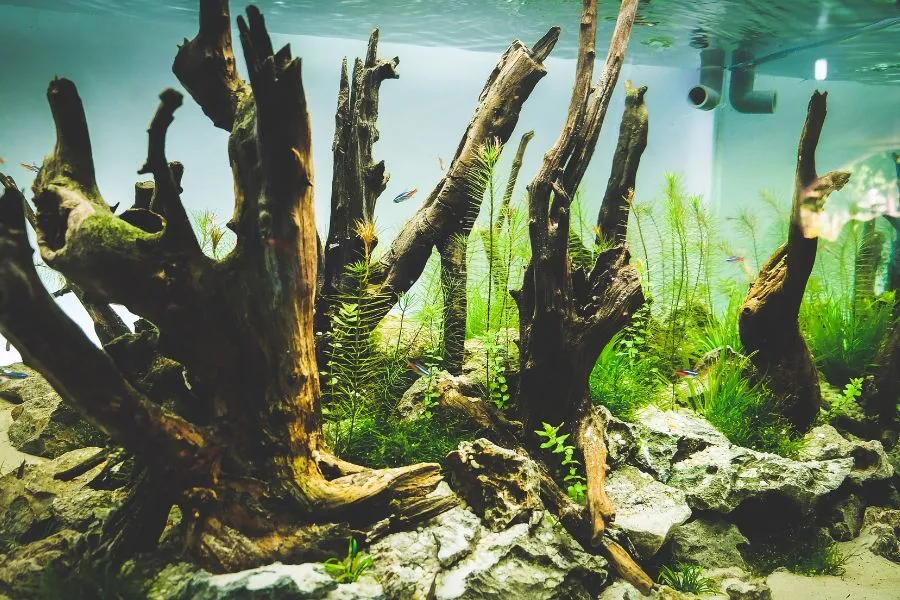
If you are an experienced fish keeper, you may already know how much space each animal in your tank needs. However, you should reference this info online by doing a quick Google search.
Once you know how much space they need, you should estimate the volume of your tank with the driftwood in it. That way, you can be sure adding some driftwood to your tank won’t cause your aquarium to be overcrowded.
Estimating how much space driftwood will take up (water volume)
Driftwood comes in many different shapes and sizes. Therefore, you need to somewhat estimate how much water volume a piece of driftwood will take up.
It’s best to estimate on the higher side. That way, you can be sure there will be more than enough water volume per fish or animal.
The way to estimate it is by using a volume calculation that is closest to the shape of your driftwood. For example, if driftwood is long and circular, then use a cylinder volume calculation. Whereas if it’s somewhat square or rectangular, then use the rectangle volume calculation. Doing so is very simple.
Here’s an example:
- You have a piece of driftwood that is mostly rectangular
- It is roughly 5 inches by 5 inches on the ends(12.7 cm by 12.7 cm). And is 1 foot long (12 inches or 30 cm).
- Multiply 5 inches by 5 inches by 12 inches.
- You get 25 inches times 12 inches = 300 inches cubed or 300 cubic inches.
You can then do a volume calculation by converting square inches to gallons. You can do this by using a cubic inch to gallon calculator by searching for one on Google.
For this piece of driftwood, it would take up 1.3 gallons of water in your aquarium.
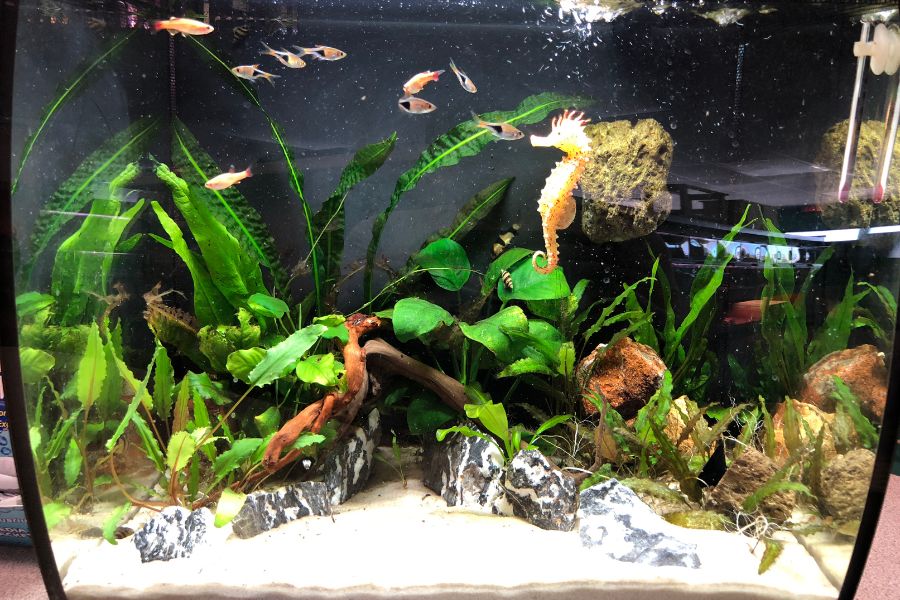
The same method also applies to using metric measurements. For example, you can get the volume of a piece of driftwood in cubic centimeters, and then convert it to liters using Google.
After you have how much volume of water a piece of driftwood takes up, you can subtract that from the volume of your fish tank. Doing so will give you what the volume of water in your aquarium will be with the piece of driftwood in it. That way, you can make sure the animals in your fish tank have enough room to be happy.
How all driftwood should be prepared before putting it in an aquarium
No matter where you get your driftwood from, it should be prepared before putting it into an aquarium. This is a simple process, but it does take some time. The main reasons for doing so are to:
- Remove most of the tannins
- Kill any parasites in the wood
- Make the driftwood water-logged, so it doesn’t float
There are two different methods for preparing driftwood. One is to soak it in cold water with vinegar and soap, and the other is to boil it. Soaking it in cold water works well. However, it takes a very long time. Often months. Whereas boiling it only takes 12 hours or so.
The idea is to boil it until the water turns the color of black tea. Then change the water and boil it again. Repeat this process until the water doesn’t change color.
This can be an issue if the piece of driftwood is particularly large or funny-shaped. Therefore, you should aim to only get pieces of driftwood that you can easily boil with the pots and pans you have. For the entire process of how to prepare a piece of driftwood for an aquarium, refer to this video:
Does Driftwood Affect Fish
Driftwood looks particularly good in a fish tank. Unlike artificial ornaments that have no effect on the water quality, driftwood is completely natural and releases organic matter into the water. So, this is if driftwood has any positive or negative effects on fish.
Overall, driftwood does affect fish. Driftwood provides a surface for beneficial bacteria to grow and places for fish and animals to hide. But, some species of trees contain toxins, so should not be used in an aquarium. Driftwood should also be prepared so that the tannins are removed.
Tannins are mildly acidic and will raise the pH very slightly. Tannins also discolor the water. Tannins can be removed from driftwood fairly easily. Refer to the video a bit further up in the article that explains and shows how to remove tannins from a piece of driftwood.
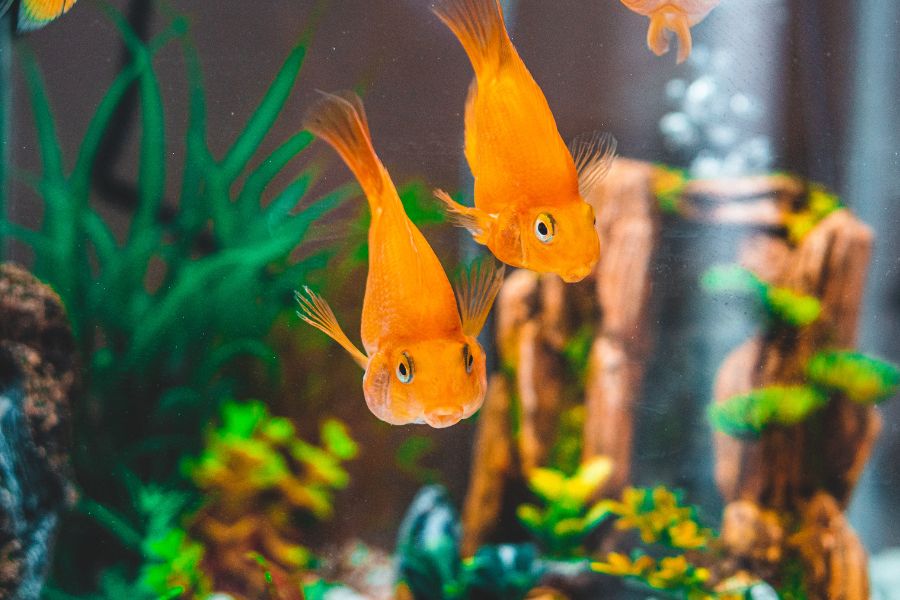
To know what species of trees should not be used in a fish tank, refer to the info at the bottom of this article, where there is a list of tree species that should not be used. Another issue with driftwood is most pieces are reasonably large. Therefore, they will displace too much of the water in a fish tank.
Interestingly, driftwood will also grow fungus on its surface, which is good for a fish tank. Also if you are keeping aquatic snails, they will graze on the fungus and algae, and provides the snails with an additional food source. However, snails won’t eat driftwood.
If you are keeping turtles, they can begin to chew on driftwood. It can be a bit confusing at first why this is. However, there is a good reason for it. I explained it in detail in this article about whether turtles eat driftwood.
Does Driftwood Lower pH Aquarium
Fish and other animals that you keep in an aquarium are sensitive to changes in pH. Each animal has a certain pH that is comfortable for them. Adding driftwood is commonly done in aquariums, so this is if driftwood will lower the pH of an aquarium.
In general, driftwood will lower the pH in an aquarium. Driftwood, like all organic plant matter, releases tannins as they decompose. Tannins are mildly acidic and will be present on the surface of driftwood. It’s a common practice to prepare driftwood first by removing the tannins.
To remove the tannins from a piece of driftwood, it needs to be boiled for about 10 hours. There is a video a bit further up in this article that shows a full method to remove the tannins from a piece of driftwood.
After the tannins have been removed, they will be released so slowly that they won’t have a significant effect on the pH of an aquarium.
Can You Use Any Type of Driftwood in an Aquarium
Natural driftwood can be found in many different places, such as on the banks of rivers, lakes, and on beaches. Because fish and animals in an aquarium are sensitive to water quality, it’s important to know if any type of driftwood can be used in an aquarium.
So, here’s everything you need to know about whether any type of driftwood can be used in an aquarium.
Some species of driftwood should not be used in an aquarium. They rot quickly or have toxins in the wood. The following driftwoods should not be used in an aquarium:
Cedar, Cypress, Grapevine, Horse chestnut, Lilac, Ivy, Pine, Spruce, Walnut, and Yew. Below are woods that are safe to use.
According to INJAF.org, the following woods are safe to use in an aquarium:
- Alder
- Apple
- Beech
- Birch
- Cherry
- Hawthorn
- Heather
- Oak
- Pear
- Sycamore
They also state that any trees that are evergreen should not be used. Another easy way to know if a piece of driftwood is safe to use in an aquarium is to buy it from a pet store. Identifying what kind of a tree a piece of driftwood is, is difficult. The only way to know for sure is to inspect a piece of the end grain under a microscope.
A not so full proof method is to see what types of trees are common in the area where you found the driftwood. But it would be a guess.
Therefore, to be on the safe side, it’s best to buy a piece of driftwood from a pet store. Or, to only buy a piece of driftwood if the seller clearly knows what species of tree it is from.

